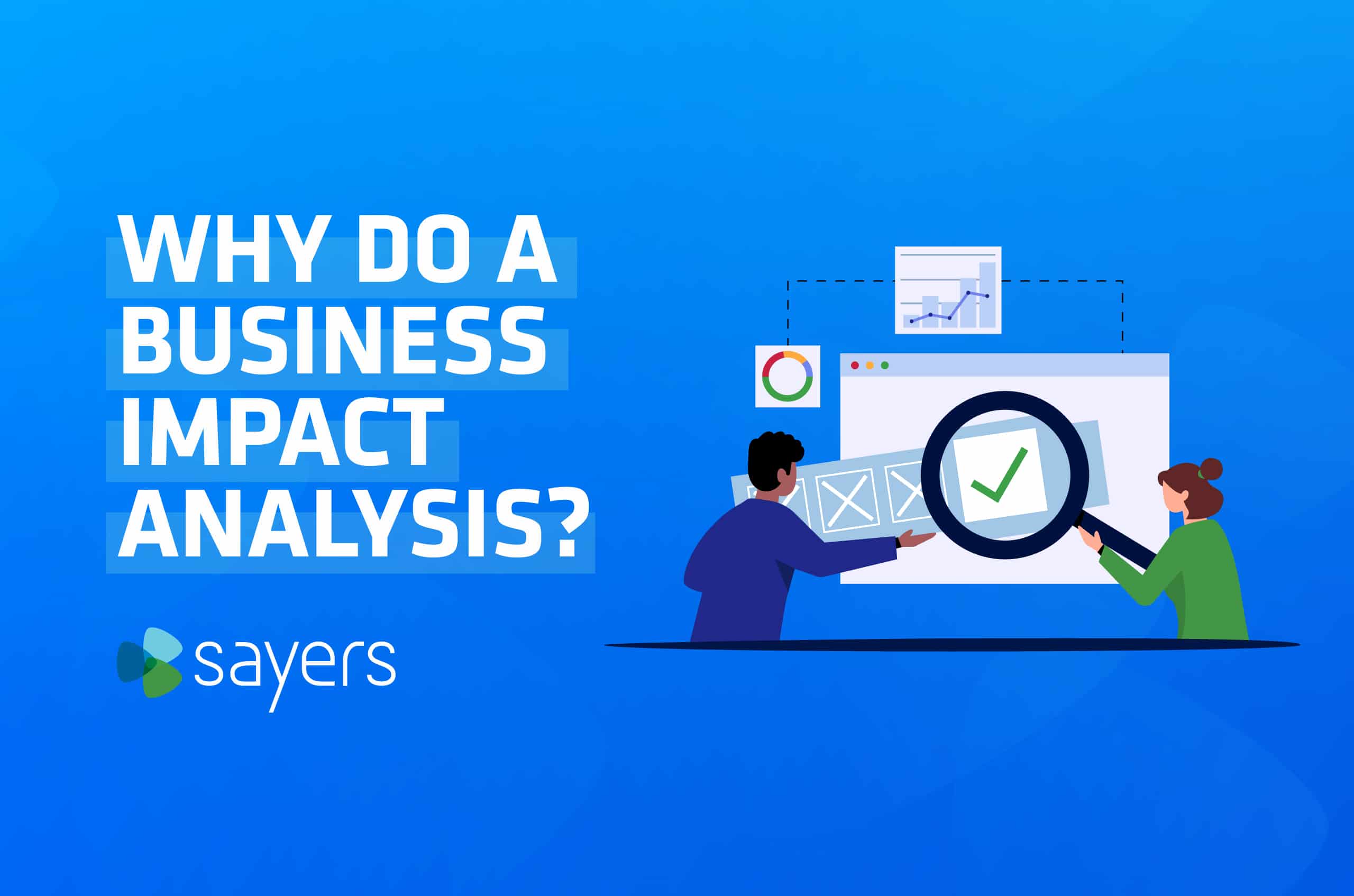At its core, Business Continuity is a robust approach to preparedness and organizational readiness for the purpose of keeping your business fully functional before, after and even during a disruptive event. At Sayers we treat Business Continuity as a practice, not a product.
Solutions Custom Tailored For You
Achieve Synergy Across Product Teams
Be Prepared When Disaster Strikes
Fill out our form below to get your consultation started. A Sayers representative will be in touch for more details.

We offer a host of services to help address your Business Continuity needs.

Prepare for a ransomware attack with our Ransomware Readiness Workshop, specifically designed to help you understand and mitigate risks.
Assess your Disaster Recovery Program based on the Capability Maturity Model Integration (CMMI) Maturity Rating Scale.
Assess the Maturity of your Business Continuity Program and see where it could use some improvement.
Business Impact Analysis tools and Business Continuity Management tools can help you collect more complete data and conduct deeper analyses of the results. Read more about the importance of conducting a Business Impact Analysis.
Read More

Whether you are new to the concepts of BC, or simply seeking a refresher on current BC best practices, let Sayers Technology’s staff of seasoned technical experts share their knowledge and personal experience in this informative workshop for customers.
Design BC policies and processes through collaboration with other business units.
Make BC part of the IT organization’s “DNA” by design.
Collect and analyze data on which infrastructure components support various business activities

Architect BC solutions capable of handling disruptions ranging from isolated outages to complete Disaster Recovery (DR) scenarios.
Adhere to best practices for implementing BC solutions into production environments.
Verifying the organization’s readiness for the unexpected through regular testing.

To prepare your business for a disaster, it’s essential first to understand where the technical and operational vulnerabilities within your current Business Continuity plan and IT environment are located. We start by performing application dependency mapping to ensure your technology investments are efficiently protected by solutions that fit your needs.
Get Started
Familiarity and luck are not enough to build a resilient business. Instead, an organization’s culture needs to be prepared through education and planning. This philosophy in regards to Business Continuity is why at Sayers, we focus on educating our clients on industry best practices first. This way, we can develop a plan that you know works, and you can rely on even in the worst situations. Here are resources to help you get prepared!
Learn More

Business Continuity is preparing your business to continue operations in the face of adverse conditions. Those conditions might be a natural disaster, they may be interruptions to your supply chain, or something that impacts your workforce. A mature Business Continuity Program takes many different potential business interruptions into account.
Disaster Recovery is a vital part of Business Continuity, but the two are not interchangeable. Disaster Recovery generally refers to the recovery of data and systems following a multi-system outage of some kind. But, there are many ways that your business could be impacted where a Disaster Recovery Plan would not need to be activated.
For example: If there was a fire overnight at a building across the street from your headquarters, the fire department might have the street blocked off and your people would be unable to get to work. This could absolutely impact your ability to do business, but since your building was undamaged, there would be no need to activate a Disaster Recovery Plan. Having Business Continuity Plans to handle the temporary loss of a facility, however, would be very useful in dealing with that situation.
Yes! Whether you’re new to BC concepts or want to reevaluate your current processes, the BC Workshop is executed by certified experts and was designed to create total alignment between your people, processes, and technology.
If your business becomes infected with ransomware, there is no guarantee that paying the ransom will get your data restored. In fact, if you’ve been infected once it’s very likely you will be ‘re-ransomed’ again in the future if that initial infection (and the security flaw that caused it) has not been eradicated.
The most effective way to recover from a ransomware attack is to have a solid, tested, Disaster Recovery Program in place. Ideally, your business has immutable backups of your data that allow you to restore to multiple points in time. That way, you can restore individual systems to a state prior to becoming infected, completely eradicating the infection.
There are several methods of testing a Business Continuity Plan, but the most common is to do what is referred to as a “Tabletop Exercise”. During a Tabletop Exercise, unit managers will get together (usually around a table) and are presented with a scenario that could potentially impact the business. That scenario could be anything from facility being unavailable, to a large regional event affecting the workforce, or even an active shooter incident. What those managers then do is reference their Business Continuity Plans to see how effective they are in responding appropriately to the scenario presented. This isn’t necessarily a case where there are a lot of right or wrong answers, the point of the exercise is to become more familiar with plans and test their effectiveness in varied situations.
The most important part of a tabletop exercise, however, is what happens afterwards. Managers should look critically at their plans and see what areas could use improvement, based on how well they were able to respond to the scenario during the test. In the days following the test, managers should plan on going through their Business Continuity Plans and updating them based on what they learned during the test.
Business Continuity can be a bewildering subject, and since it touches all aspects of the business, it’s difficult to know where to get started. A good place to start is with a Business Continuity Program Maturity Assessment. A properly done assessment will help you see where you are in the process of building a program and give you an idea of what areas could you use attention to bring you in alignment with best practices. Ideally, an assessment like this would be repeated periodically so you could continue to see how your program is maturing, and so you can better determine where to put your efforts to Continue to improve the overall program.
The art of Business Continuity is to coordinate all aspects of your business to prepare against all foreseeable disruptive events. Many organizations only focus on the technical aspects of BC, but Sayers knows a well-rounded BC plan involves cooperation and unity across all departments.
Our Business Continuity Workshop averages two business days with coordinated organizational department involvement, but deliverables are time-tailored specific to the organization. We take care to provide comprehensive solutions based on the workshop discovery.